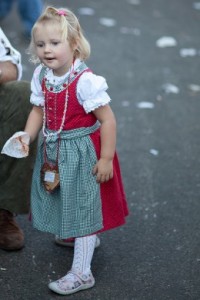This past week, I had the opportunity to spend some time traveling in Germany, a country I had not previously visited. Luckily, I also happened to visit the beautiful city of Munich during the Germany vs Brazil World Cup Semi-Final game. Soccer, known as football in most countries, is a global phenomenon that engages the attention of billions. The World Cup is much more than a series of games. For many fans, both young and old, it is a chance to express their national pride, heritage, and culture. As an American who has only experienced German culture through a handful of Americanized Oktoberfests, I was excited to be a part of the culture for a few days. I listened to traditional music, struggled with speaking German, and tasted amazing Bavarian dishes.
Above everything, the traditional Bavarian clothing enchanted me the most. I was delighted and surprised that so many German boys and girls wore the dirndls and lederhosen that I had previously assumed were inaccurate and stereotypical. Intrigued, I needed to know more about the beautiful and colorful dresses that I saw in nearly every store in Munich. A traditional dirndl consists of a blouse (usually white), bodice, full skirt, and apron. Originally, the word dirndl referred to the young woman wearing the dress while the word dirndlgewand referred to the dress. Today, dirndl is used to either describe the wearer or the dress. This traditional outfit began as a uniform for Austrian servants in the nineteenth century. In the 1870s, upper-class women adopted the dress as high fashion and thus expanded the popularity of the dirndl.
Dirndl-wearers can be found all over Bavaria and Austria. Older women tend to wear them every day, while younger women prefer to wear them during festivals, like Oktoberfest, or times of national pride, like the World Cup.
Dirndls are a wonderful symbol of old traditions merging with a growing modern world. It is important for societies to retain historical aspects of their culture and traditional clothing can be a great way to unite generations.
-Casey Gymrek
Junior Girl
Girl Museum Inc.
Tags: Dirndl, Culture, German, Clothing

